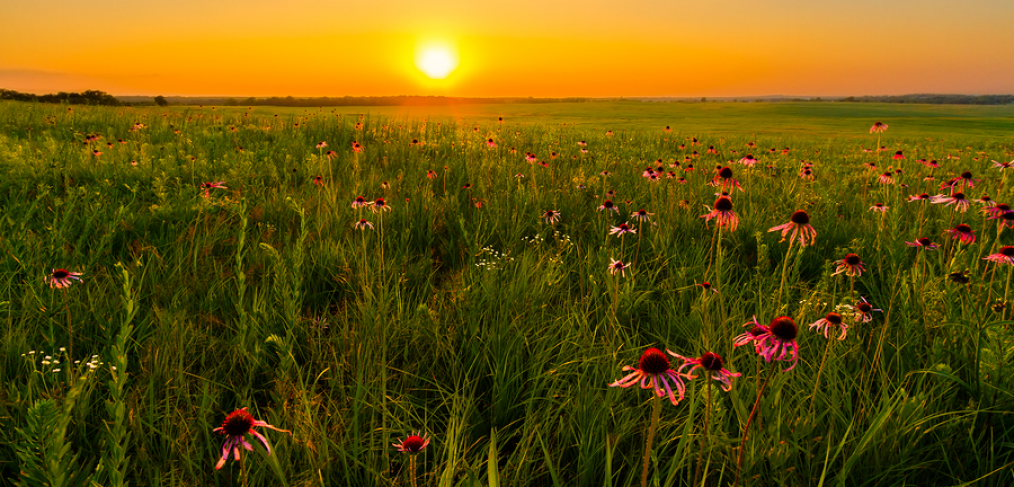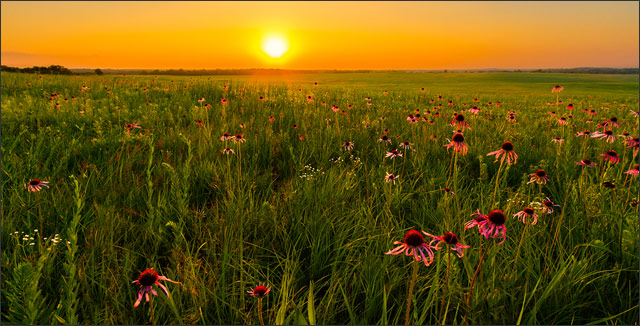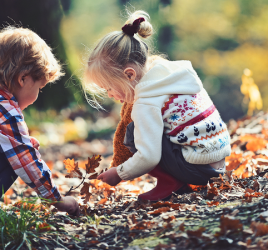
American Prairies: Diverse, Important and Disappearing

Have you ever read Laura Ingalls Wilder’s Little House on the Prairie series? What does this have to do with American prairies? Please stay with me and you will see…
I read the Little House on the Prairie series as a child, over and over again. I was fascinated by the rich picture Laura paints of prairie life before many settlers came to the area.
The Ingalls family settled for one year on the Osage Diminished Reserve near Independence, Kansas. As the book chronicles, they left their homestead when news they thought they’d received of the U.S. government’s intentions to allow settlers on the Osage land proved false. They received word that soldiers were coming to escort settlers off the land.
Charles and Caroline Ingalls would have been one of the prairie’s first settlers and one of the first farms in its many thousands of year history. It’s no wonder Laura remembers Charles exclaiming over the richness of the soil, the dense root system his plow overturned, and its almost complete lack of big rocks or trees.
Kansas, at that time, was part of the huge swath of land – encompassing the U.S. states of:
- North Dakota
- South Dakota
- Montana
- Nebraska
- Kansas
- Oklahoma
- Texas
- Wyoming
- Colorado
- Mexico
- And the Canadian provinces of Alberta, Manitoba, and Saskatchewan which we think of as the Great Plains.
How the Great Plains Were Formed
The Great Plains were formed as the Rocky Mountain range was formed by the Earth’s tectonic plate movement and sheltered this vast area eastward from the amount of rain need for dense tree growth – or so the theory goes. What grew instead was dense and incredibly diverse population of grasses and wildflowers.
As Laura Ingalls Wilder’s descriptions illustrate so beautifully, these plants became the source of all shelter and nourishment for a teeming army of wildlife that included wild hares, chickens, groundhogs, mice, turkeys, deer and wolves, just to name a few.
The temperatures and average rainfall covering this huge tract of land is also, predictably, diverse, but is generally more moderate than in other areas of the country because of the shelter it receives from the Rocky Mountains.
North American prairie land can be categorizes as wet, mesic and dry. Wet prairie soil doesn’t drain water well. Mesic prairie soil holds moisture well and drains well, making it some of the richest and most fertile soil in the world.
The Canadian province of Saskatchewan is known as the “bread basket of Canada.” Dry prairie soil is usually found in more elevated spots, has not been useful for agriculture and therefore has retained more of its original flora and fauna than its wet or mesic counterparts.
Why Are Prairie Plants Important?
As you may have guessed or already know, the mesic prairie systems have all but disappeared. They have been replaced and destroyed by farming. According to National Geographic, all but 1% of the Great Plains original plants have been replaced by farmed grasses – wheat, rye and oats, and corn.
The reason these farmed grasses do so well in mesic prairie soil is the same reason native prairie grasses did so well. The only hills are small – less than 4 feet tall. In addition, there are no trees to remove in order to create large, open fields.
Native prairie grasses had another important function: prevention of soil erosion and drought resistance. This means they are especially adapted to have deep root systems which reach to water tables which are found at a deeper depth than in other kinds of ecosystems.
I’ll never forget the chapter in Little House on the Prairie where Pa risks his life to save his neighbor, who has breathed in toxic fumes in the very deeply dug well. Here’s a quote from a periodical about prairie land in the Ozarks that fascinated me (italics mine):
Fragile Types of Plant Communities
Prairies are one of the most fragile types of plant communities. Prairie plants as a rule require fire to keep out other plants. They are long-lived perennial plants, and in some virgin prairies, some of these plants have lived for centuries in the same place. Each plant has its own niche, so very few new seeds germinate because there is no room for new plants. Prairie plant life is very diverse. An undisturbed prairie might have a carpet of wildflowers blooming from early summer through fall with perhaps 150 to 200 different species of wild flowers in an acre.
Unfortunately, with the destruction of this diverse group of plants by farming by the mid 20th century came not only the loss of diversity, but the enormous erosion of soil once its naturally occurring protection was removed. Planted crops could not withstand the horrible droughts of the 1930s, which resulted in the American Dust Bowl phenomenon of that time period. It displaced and killed thousands and thousands of people; not to mention changing the ecology of a huge part of our continent forever.
Prairie Restorations
Because we are still a large agrarian society, and our current farming practices rely on the enormous amounts of grain we reap from Great Plains farmlands, the once-teeming prairies are not likely to be restored to their original splendor any time soon. A growing body of conservationists are trying to shed light on this problem, however. The American Prairie Reserve is “located on the legendary high plains surrounding the Missouri River in northeastern Montana” and you can visit and support in many ways.
How You Can Help America’s Prairies
There is a way you can help restore some of the diversity and beauty that was lost in your own state as well as attract wildlife you wouldn’t otherwise see in your own back yard.
You can begin by checking your Conservation District office to find out what types of habitats were discovered by the original surveyors before your area was settled.
If you don’t live in an area that was prairie, you might not have luck planting huge areas of prairie grass and wildflowers. However, that doesn’t have to stop you from planting things known to be friendly for migratory birds, bees, and butterflies. They are more in danger than ever because of suburban sprawl pushing their natural resting habitats further and further apart.
You can also inspect your area with a field guide for remnant grasses and plants. Remember, prairie plants are hardy! In some areas, wild plant seeds remain dormant for over 50 years. You may be able to re-activate wild plants by removing or tilling your grass and waiting. Your state may have a guide to this important restoration process.
Take Away
Prairie lands are more important in their unspoiled state than the generations before us may have understood. Of course, industrialization was still around the corner when the Ingalls family settled in Kansas. Though he clearly thought of prairie land as his natural right to farm, no doubt Charles Ingalls would have been dismayed by the farming practices that ruined the prairie, if they had occurred in his lifetime.
We can each do our part to help conserve and restore what has been lost so our own children and grandchildren have a chance to see some of what Laura Ingalls Wilder experienced firsthand: the glory of a self-sustaining and perfectly adapted ecosystem at its pinnacle.

